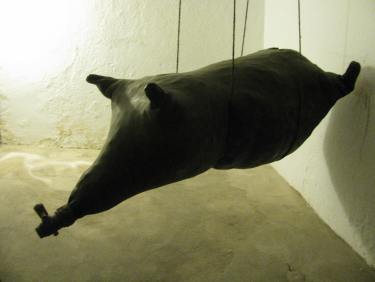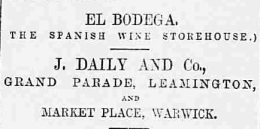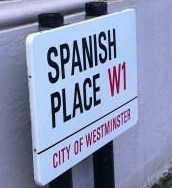Having spent the last couple of weekends playing carols at the Yule tide Fair on Leamington Parade (above), I was tickled when browsing through the British Newspaper Archive to come across the Leamington Spa Courier‘s report of the town’s Christmas displays on the same Parade 142 years ago. Christmas shoppers making their way down Leamington’s Grand Parade in December 1871 were greeted, amid the stars and sparkling lights, by an unexpected sight. In the window of no.4, home since the previous year to James Daily’s Spanish Wine Stores,
there were signs of [Daily’s] recent travels into the wine-growing districts of France and Spain. Here are models of the Sherry-grower, the man of Oporto, and the agriculturist, to whom we are indebted for the rich and cheering produce of the grape in Castile, Andalucia, and other wine-growing districts. Here too, is a real skin wine vessel, “very like a pig,” with its nose for a spout, and near it are the bottas of the peasantry, which you may literally squeeze for the last drop. Some people daily take their wine, but here you may take yours with Daily, whose spirits are unsurpassed, and his Spanish wine storehouse not to be rivalled (Leamington Spa Courier, 23 December 1871).
While I haven’t managed to locate a photo of Daily’s display, this wine pig – which I found at the Museo del Vino in Lanzarote – gives a hint of what Leamington’s Christmas shoppers of 140 years ago would have encountered, although sadly without the accompanying (waxwork?) figures.

The display evidently gave Leamington’s 1871 Christmas celebrations a strong Iberian flavour. But who was James Daily? Leamington local historians will be familiar with his earliest and most sustained incarnation as a mineral water manufacturer who ran into trouble after selling his company, J Daily & Co., to a business rival in 1871 (you can read an account here in the Leamington Society Newsletter – scroll to p.6). Daily, born in Charleville, Co. Cork around 1825, had been making mineral or soda water in Warwick and Leamington since at least 1849, moving between properties in Satchwell St, Regent St and Brook St. By 1861, he had expanded into cork – the 1861 census records him at 37 Regent St, employing 12 soda water makers and 4 cork cutters – and by 1866, he was also importing cigars and acting as local agent to the London-based wine merchants, W & A Gilbey (Morris’s Commercial Directory of Warwickshire, 1866).
In December 1863, Daily’s life was transformed by the death of his first wife, Eliza, just days after being ‘safely delivered of her seventh child’ (Leamington Spa Courier, 26 Dec. 1863). He remarried eighteen months later at Warwick St Mary, to Rebecca Lees, and this second marriage appears to have been the catalyst for a change of professional direction, signalled in the couple’s choice of name for their first son: Dionysius. By March 1867, now describing himself as a wine merchant, Daily had taken premises at 4 York Terrace, which in a letter to the Leamington Spa Courier, he proposed renaming as ‘Grand Parade,’ in order ‘to remove the present indistinctiveness between York Terrace and Lansdowne Place.’ Subtly reminding readers of his business success, Daily proposed to promote the new name ‘on my five vans, on my bill-heads, and on some 50,000 circulars which I annually send out’ (22 Jun 1867).
Daily’s plan worked, and 4 York Terrace became 4 Grand Parade (now simply The Parade).* He began to lay the groundwork for his new project – literally, as he excavated cellars in Tavistock St, to the rear of Grand Parade, capable of holding 500 casks of ale, and cellars under a warehouse in Kenilworth St ‘built out of solid rock’ to hold another 1000 casks (Leamington Spa Courier, 3 Dec. 1870). He also began building the connections with Spain and Portugal that would underpin his Spanish Wine Stores, and although these connections remain obscure, we can gain a glimpse from another letter he published in the Courier in March 1869, describing a treasure hoard he had been told about while walking in Portugal.
 Daily’s new business launched in the summer of 1870, its not-terribly-grammatical name of El Bodega** most likely inspired by the booming nationwide success of Robert Lavery’s Bodega Company (of which more in a future post…). According to an advert Daily placed in the local paper, the Leamington Bodega was an immediate success, transporting 76 and 79 tons of goods in July and August respectively (Leamington Spa Courier, 10 Sep. 1870). The following year, presumably counting on the Bodega’s continuing success, he sold his mineral water business to the Kinmond brothers for £2000. This sale and its aftermath were to be his downfall.
Daily’s new business launched in the summer of 1870, its not-terribly-grammatical name of El Bodega** most likely inspired by the booming nationwide success of Robert Lavery’s Bodega Company (of which more in a future post…). According to an advert Daily placed in the local paper, the Leamington Bodega was an immediate success, transporting 76 and 79 tons of goods in July and August respectively (Leamington Spa Courier, 10 Sep. 1870). The following year, presumably counting on the Bodega’s continuing success, he sold his mineral water business to the Kinmond brothers for £2000. This sale and its aftermath were to be his downfall.
So what did Daily’s bodega bring to his Leamington customers? His principal selling point was the ‘friends and relatives in Andalucia and Catalonia’ whose good offices allowed him ‘to avoid Shippers, Merchants, London Bottling Houses and Country Agents’ profits, all of which we offer to the consumer in QUALITY, PRICE, and DISCOUNT’ (Leamington Spa Courier, 9 Dec. 1871). His weekly newspaper adverts, describing the seventeen types of sherry available through the Bodega, have a notably didactic flavour, instructing customers on the differences between, for example, type B (‘this is the kind of Wine drunk by the people of the Sherry district’) and type N (‘A soft, old, full-flavoured Wine, with exquisite bouquet; the kind of Sherry so much appreciated before the taste for dry Wines became the fashion, and to which old-fashioned styles of Wine connoisseurs are rapidly returning’). He also offered a good value cooking sherry: ‘Very dark color, and very full-flavoured strong wine: for all purposes of the Cuisine, for flavorings and confections, it will be found more suitable than a higher-priced Wine’ (Leamington Spa Courier, 7 Jan. 1871). I’m thirsty just thinking about it…
Sadly, Leamington wine-lovers had little time to enjoy their own Spanish Wine Storehouse. In 1873, Daily was prosecuted by the Kinmond brothers, who had bought his professional name along with his soda water business, and were furious about what appeared to be his continued use of the name in defiance of their contract. The case was complicated by the presence of Daily’s brother, also James (‘our’ James had in fact been born ‘Patrick’ Daily), who had relocated from London and set up a mineral water company trading on his brother’s name recognition. The brothers exchanged a great deal of correspondence in the local press, with claims and counterclaims: one stated that their father had named all his sons James, while the other countered that the second James had received his name while the first was believed lost at sea. The upshot, however, was that in 1874, Kinmond won a perpetual injunction against ‘our’ Daily, who was ordered to pay the not inconsiderable costs. He left Leamington in disgrace, settling in Southampton, where – respectably recast as a ‘retired wine merchant’ – he died on 1 March 1890 at the age of 55.
Leamington’s Spanish Wine Storehouse survived for just three years, and we still know little about the Spanish connections Daily developed following his second marriage (his wife’s background gives no clue). But for those three years, James Daily shared his enthusiastic discovery of Spanish and Portuguese wines, their character and history with his fellow Leamingtonians. I wonder what happened to the wine pig?
________________________________________________________________________
*Daily’s premises were at the top end of the Parade close to the corner with Clarendon Avenue,more or less where Hammonds is now.
** ‘Bodega’ is a feminine noun in Spanish, so the correct form would be ‘La Bodega.’

